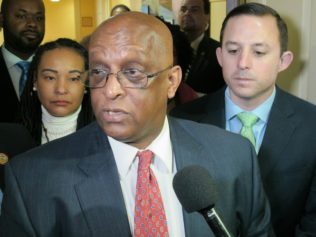There is little doubt the Perkins Transformation Project will transform the city of Baltimore. In August, the Housing Authority of Baltimore City (HABC) selected Beatty Development to lead the team to redevelop the troubled Perkins Homes, a 75-year-old public, low-income complex housing more than 600 families. The private company is planning a leading-edge, mixed-income development at the 17-acre site which sits adjacent to its current development, Harbor East, a high-end community featuring towering hotels, lush apartments and corporate plazas.
There is considerable concern over how it will transform the city. Given the increasing lack of public and affordable housing in Baltimore — a city contracted to sell off nearly half of its 10,300 federally subsidized apartments to private companies, and where 28 percent of residents live below the poverty line — some feel the new project is a litmus test on the type of city Baltimore will ultimately become.
“It could go one of two ways,” said Barbara A. Samuels, managing attorney for ACLU of Maryland’s Fair Housing Project. Samuels noted the irony of how public housing like Perkins Homes, which traditionally has been regarded as standing in one of the city’s least desirable locations, is now side by side with the so-called “Gold Coast,” Baltimore’s new mecca for affluence.
“It’s got real potential to break down what we call the ‘Two Baltimores’ and create an economically and racially integrated community and school there around the Perkins site,” Samuels said. “Or it could go completely the other way and become a mechanism for removing public housing, low-income people and, specifically, low-income African-Americans who live next to this new luxury area.”
There is ample reason for doubt. Across the country, wealthy private developers have been known to raze and “revitalize” low-income housing projects, receiving federal and state subsidies and tax breaks to do so. After the renovation, even despite “mixed-income” designations, former residents are commonly displaced given their inability to afford the new rents. In 2016, the National Low Income Housing Coalition reported a shortage of 7.2 million affordable and available rental units for the nation’s 10.4 million extremely low income (ELI) households, the bottom 30 percent of income-earners in their communities. Three-fourths of these ELI renters spend over half their income on housing, with little left for such basics as food, child care, transportation and monthly utilities.
“They’re pursuing a very high-class, capitalist strategy to basically dismantle public housing in Baltimore,” said Dr. Lawrence Brown, professor of public health at Morgan State University and an advocate for African-American neighborhoods. Brown cites reports by Joan Jacobson and the Abell Foundation on the dismantling of Baltimore’s public housing — a 42 percent decrease in occupied units from 1992 to 2007 — as evidence of the foundation of a continuing trend.
However, the city and its private development team see a different trend. “HABC is excited to move forward with the Perkins Transformation Project and collaborate with Perkins Point Partners, the community, and other key partners to improve housing access, resident success, and neighborhood vibrancy,” said Janet Abrahams, executive director of the Housing Authority of Baltimore City, in a statement posted by Beatty Development. “It’s the beginning of a renaissance in this neighborhood. The long-term vision of the project is to restore Perkins Homes and the surrounding community by replacing distressed public housing with high quality housing for people from all income levels.”
Part of the city’s plan is to apply for a $30 million federal Choice Neighborhoods grant, which stipulates the replacement of every subsidized unit. However, this highly competitive and dwindling Obama-era program could fall victim to President Trump’s proposed budget cuts for 2018, leaving the city to backtrack on its commitment to affordable units as a means of keeping developers on board.
“I think there is sort of an inherent conflict of interest there,” offered Samuels, given the development team the city is currently negotiating with is the same one that developed Harbor East. Their interest, said Samuels, is to protect their development and investors more than to “build, design and implement this in a way that is in the best interest of the Perkins residents or other low-income residents of Baltimore who need affordable housing.”
With the rapidly increasing privatization of public housing, such concerns have become more common. The Rental Assistance Demonstration, or RAD, is a federal program begun in 2013 ostensibly aimed at preserving existing public units through access to federal funding. Given its handing over of public housing to private management — even with a current program cap, the program has already transferred 2700 units into private hands in Baltimore alone — the day when there is no longer a ‘public’ in public housing may not be far off. And there is a strong push by developers and political leaders for the expansion of RAD and the lifting of the cap set during the program’s initial phase.
That said, alternative solutions have been floated. A number of Baltimore community groups have been backing the concept of community land trusts as a way of employing RAD to maintain affordable housing in the city. These trusts preserve land and property for the public good, whether applied to a single home or a community, by taking those public funds to subsidize affordable mortgages and rents while residents share in the equity with other community members. The trust, by design, ensures affordable housing for both current and future residents, as all profits are turned back over to the trust. A recent local effort, United Not Blighted, has pushed for $40 million to be added to the city budget for community groups to rehabilitate properties and convert them into land trusts.
However, while some believe this could be an effective solution, they are less inspired by the public leadership required to implement it in an effective way.
“You would have to have a willing Housing Authority of Baltimore City,” said Brown, noting their ongoing dismantling of public housing and how “they tend to favor these market-oriented approaches that result in land dispossession of their property and the gentrification of those locations.”
“So one has to wonder,” continued Brown. “What is it that’s going to make the Housing Authority of Baltimore City turn around now and pursue a strategy of racial equity and resident control using community land trusts?”


